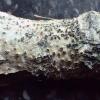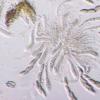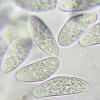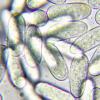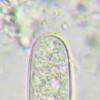
31-12-2025 19:27
Collected from loamy soil, at waterside (completel

30-12-2025 16:44
Pascal DucosBonjour,Une anamorphe rose stipitée, très nombre

30-12-2025 17:14
 Bernard CLESSE
Bernard CLESSE
Bonjour à toutes et tous,Pourriez-vous aider Albe

29-12-2025 10:15
Hulda Caroline HolteHello, I found and collected this propoloid ascom

30-12-2025 09:04
Hello.A Pyrenomycete sprouting sparsely but very d

29-12-2025 17:44
Isabelle CharissouBonjour,J'aimerais savoir si d'autres personnes au

12-11-2021 00:03
Lepista ZacariasHi everybody,A week ago in my fiels trip I noticed
Diplodia-like
Bernard Declercq,
10-11-2023 17:11
 Hello,
Hello,Collected on a fallen corticated branch of Populus x canadensis:
Ascomata and conidiomata occurring separately in the same stroma, partially erumpent, multiloculate, up to 1.5 mm diam., black.
Asci fissitunicate, elongate clavate,(4)8-spored, e.g. 150x25 µm, tapering stalk. Ascospores ellipsoid to rhomboid, inequilateral, with broadly rounded ends, aseptate, thick-walled, granular contents, hyaline, 26-37x14-16 µm (8-spored asci) or 31-48x15-19 µm (4-spored asci).
Conidiophores reduced to conidiogenous cells. Conidiogenous cells monoblastic, cylindrical to narrowly clavate, 10-15x5-6 µm, hyaline. Conidia cylindrical, 29-34x12-14 µm, with broadly rounded ends, aseptate, granular, without mucoid sheath, hyaline.
I know Diplodia and similar are not the most easy ones, but I hope someone can help me.
Thanks in advance.
Bernard
Alain GARDIENNET,
11-11-2023 11:09
Re : Diplodia-like
Salut Bernard,
Voilà longtemps de je n'ai pas regardé ces groupes là, et je ne sais pas où en sont les études, mais ça me fait penser à un Botryosphaeria. Les mesures sporales que tu donnes se rapprochent de celles de B; quercuum. Je te laisse aller plus loin.
Alain
Voilà longtemps de je n'ai pas regardé ces groupes là, et je ne sais pas où en sont les études, mais ça me fait penser à un Botryosphaeria. Les mesures sporales que tu donnes se rapprochent de celles de B; quercuum. Je te laisse aller plus loin.
Alain
Bernard Declercq,
11-11-2023 13:01

Re : Diplodia-like
Salut Alain,
Merci pour ta réponse.
En effet, se basant sur la forme, la guttulation et les dimensions des ascospores, Botryosphaeria quercuum ainsi que Melanops tulasnei pouraient convenir.
Mais j'ai du exclure ces deux espèces se basant sur les conidies:
B. quercuum a des conidies subgloboses 18-25x12-16 µm, tandis que M. tulasnei a des conidies fusiformes 41-53x9-11 µm (selon Sivanesan 1983: fig. 67 & 70).
Bernard
Merci pour ta réponse.
En effet, se basant sur la forme, la guttulation et les dimensions des ascospores, Botryosphaeria quercuum ainsi que Melanops tulasnei pouraient convenir.
Mais j'ai du exclure ces deux espèces se basant sur les conidies:
B. quercuum a des conidies subgloboses 18-25x12-16 µm, tandis que M. tulasnei a des conidies fusiformes 41-53x9-11 µm (selon Sivanesan 1983: fig. 67 & 70).
Bernard



